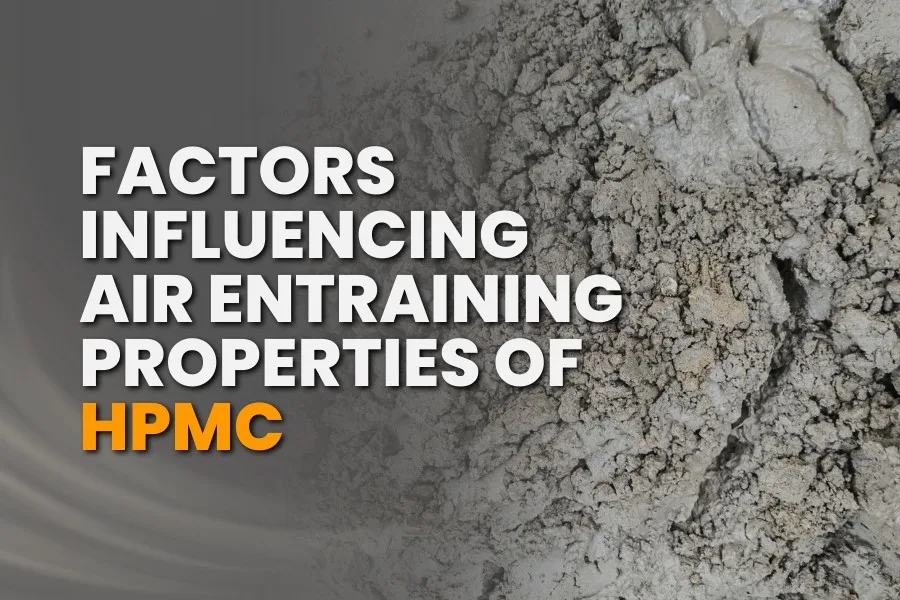In the construction industry, Hydroxypropyl Methylcellulose (HPMC) is an essential additive, widely used in dry mix mortar, tile adhesives, wall putty, plasters, and cement-based coatings.
One of the most important roles of HPMC is to enhance air entrainment, directly improving workability, strength, and durability of building materials.
Table of Contents
At Sakshi Chem Sciences Pvt. Ltd., we constantly assess and advance how we formulate HPMC so that our customers can consistently rely on the performance and quality of their construction materials. This article will cover some of the key factors of air entrainment in HPMC and how these affect the performance of cementitious products.
What is Air Entrainment?
Air entrainment is the intentional introduction of microscopic air bubbles into the mortar or concrete. In fact, microscopic bubbles are not defects; they perform a useful function, including:
Improved workability: Produces a smooth mortar that makes application easier.
Freeze-thaw resistance: Small air bubbles relieve pressure during water expansion associated with freezing and prevent cracking.
Reduced shrinkage: controlled voids reduce shrinkage stress and surface cracking.
HPMC acts as an air bubble stabilizer that keeps the air bubbles well dispersed in the mix.
Factors That Influence the Air Entraining Properties of HPMC
1. Molecular Weight and Viscosity
The viscosity of the HPMC is closely related to its molecular weight. Generally speaking, higher viscosity grades will provide more stabilization of the air bubbles and have a more favorable effect on the air entrainment performance of the mix.
However, the viscosity should not be too high, as this can make the mixture challenging to work with. It is important to find the right water and viscosity combination that will allow for the most potential entrainment and workability.
2. Degree of Substitution (DS)
HPMC is composed of cellulose, which is substituted with hydroxypropyl and methyl groups along the polymer chain. The DS of HPMC will impact the solubility and surface activity.
The higher the substitution of the HPMC with hydroxypropyl or methyl groups, the better the product can trap and stabilize air bubbles (enhances both air content and bubble stability).
3. Particle Size Distribution
Finely milled HPMC particles will disperse better within dry mixes, contributing to efficient air bubble formation and stabilization. Coarse particles or agglomeration may negatively impact air entrainment or performance from batch to batch, and if the particles are not uniform in size, it will negatively impact blending and expected results.
4. Formulation Compatibility
HPMC does not work alone, as it is always combined with cement, aggregates, surfactants or redispersible powders. The air-entraining effect of HPMC will depend on the interactions of the formulation ingredients. Incompatible formulations can destabilize air bubbles. A well-balanced formulation can provide improved stability.
5. Mixing Method and Application
The introduction of HPMC – as either a dry powder with pre-mixed formulations or a dispersion in liquid – directly impacts hydration and air entrainment. Proper mixing ensures the polymer can fully activate and then accommodate stable incorporation of air.
6. Environmental and Processing Conditions
Because HPMC air-entraining function is influenced by temperature, mixing speed, and ambient humidity, it is essential to carefully control. For example, in general, high shear mixing helps distribute air more effectively, while extreme heat tends to prematurely collapse bubbles. Strictly controlled processing conditions are critical for achieving consistency.
7. Purity and Chemical Composition
Not all HPMCs are made the same way. Differences in the cellulose source, the etherification method, and residual salts are all elements of HPMC performance.
A cheaper HPMC grade typically performs worse than a higher purity HPMC grade, as higher purity HPMC represents a predictable phase of air entrainment properties and reproducibility when comparing batches.

Optimizing Air Entrainment with HPMC
- Choose a suitable viscosity grade based on application.
- Disperse and mix adequately to achieve an even distribution.
- Explore compatibility with other additives before application to large quantities.
- Maintain appropriate processing and curing environmental conditions.
Conclusion
The air-entraining properties of HPMC rely on the balance of molecular design, formulation design, and the practical way it is applied. We help builders and manufacturers achieve consistent performance in mortar, adhesives, and plasters—leading to stronger, more durable, and easier-to-apply products.
At Sakshi Chem Sciences Pvt. Ltd., we combine decades of expertise with advanced R&D to deliver HPMC solutions that meet global quality standards. Our commitment is to help the construction industry build smarter, stronger, and more efficiently—with additives that work exactly as expected.
Sagar Telrandhe is a Construction Engineer with a B.Tech in Construction Engineering & Management. Passionate about infrastructure development, project planning, and sustainable construction, he specializes in modern construction techniques, project execution, and quality management, contributing to efficient and innovative building.


